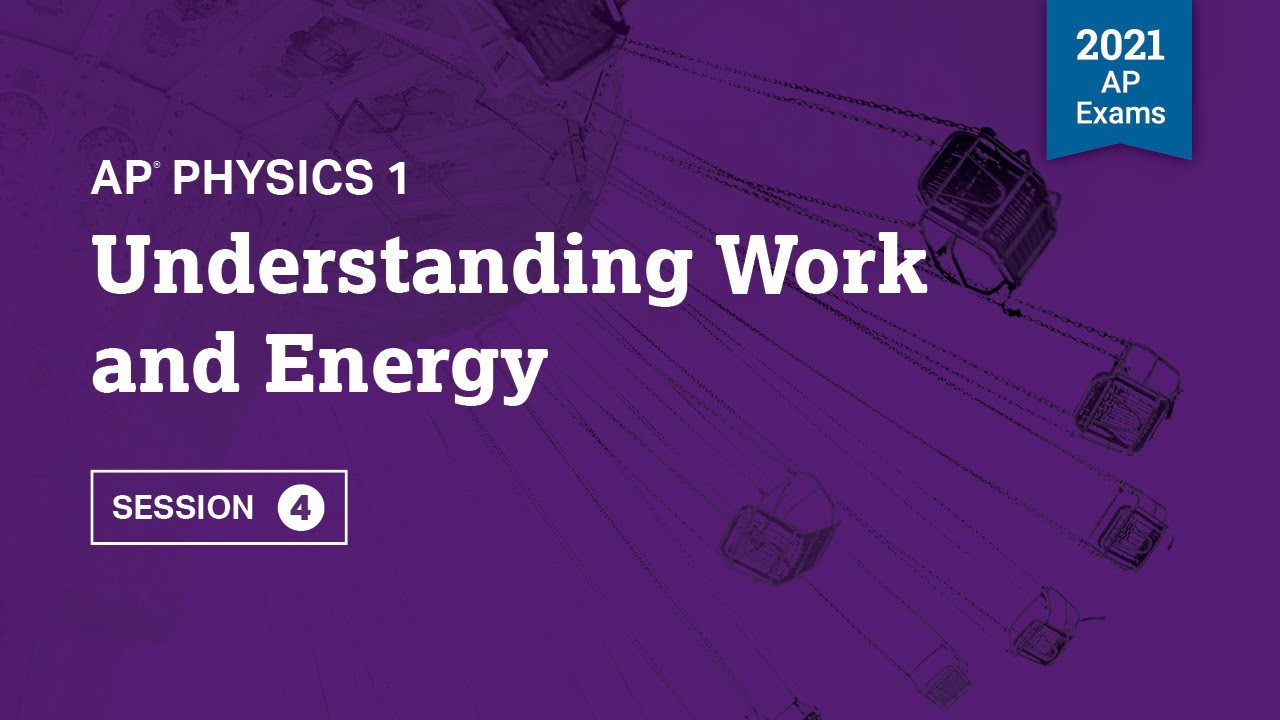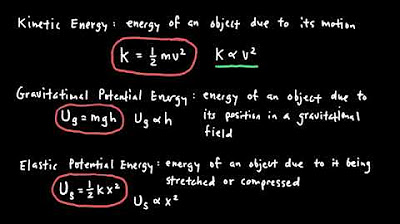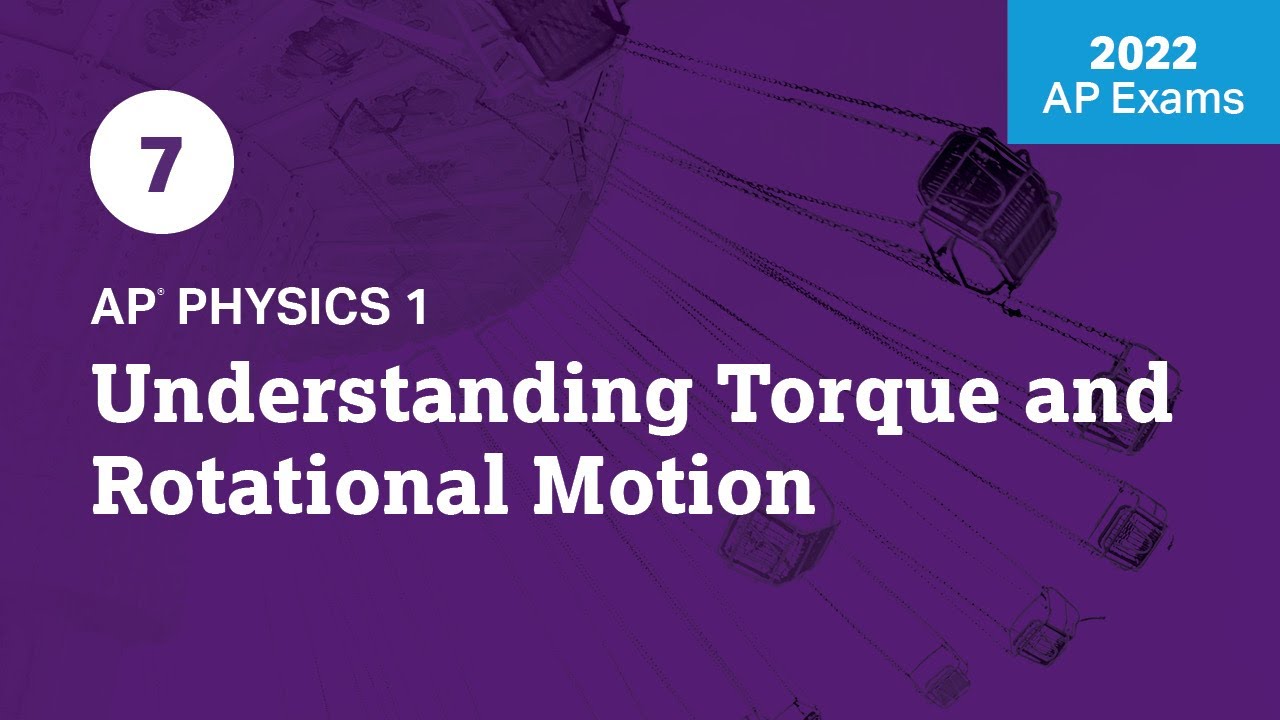2022 Live Review 4 | AP Physics 1 | Understanding Work and Energy
TLDRIn this engaging lecture, Christine Gonzalez Vega explores the concept of energy in AP Physics 1, emphasizing its importance and connection to forces causing change. She delves into various forms of energy storage, including gravitational, kinetic, and chemical, and discusses how these energies transform in different physical scenarios. Through examples involving springs, roller coasters, and pendulums, she illustrates the application of energy principles and the use of energy diagrams to solve problems. The lecture also covers the significance of system selection and the calculation of work in relation to energy changes, providing a comprehensive understanding of energy conservation and its applications in physics.
Takeaways
- 🌟 Energy is a central concept in AP Physics 1, focusing on the ability to cause change and its different storage types (gravitational, kinetic, and chemical).
- 📈 The relationship between forces and change is fundamental, with forces causing changes in velocity (acceleration), momentum (impulse), and energy.
- 🎢 Understanding energy transformation is crucial, especially in scenarios involving springs, roller coasters, and ramps where energy principles are frequently applied.
- 📊 Graphs play a significant role in analyzing energy problems, with the slope representing a ratio of forces (like spring constant) and the area representing work or energy change.
- 🔄 Conservation of energy is a key principle, stating that the total mechanical energy (potential + kinetic) remains constant in an isolated system without external forces.
- 🚀 The concept of work is essential in energy analysis, defined as a force or component of force parallel to displacement, leading to energy change in a system.
- 📐 Free body diagrams are vital tools for identifying forces and analyzing energy interactions within or outside a system.
- 🤹♀️ Energy can be approached from various angles, such as kinematics or forces, and problems in physics often involve more than one topic, allowing for multiple solution strategies.
- 📝 When solving AP Physics problems, it's important to provide explanations in words, even when using mathematical concepts and equations.
- 🏗️ Practical applications of energy concepts, like designing low friction slides or amusement park rides, require a balance between physical principles and real-world constraints.
- 📚 The ability to draw and interpret energy bar charts (lol diagrams) is crucial for visualizing and calculating energy storage and flow in a system.
Q & A
What is the main topic of the video?
-The main topic of the video is energy, specifically in the context of AP Physics 1, and how forces can cause changes in energy.
What are the different types of energy storage mentioned in the video?
-The video mentions three types of energy storage: gravitational (potential energy), kinetic (energy of motion), and chemical (energy stored in substances).
How does the speaker suggest using energy concepts to solve problems?
-The speaker suggests using energy concepts as tools in a toolbox to solve AP physics problems, considering whether a problem can be approached with energy principles or if other topics like kinematics or forces should be applied.
What is the significance of the spring constant in the context of the force and position graph?
-In the force and position graph, the slope of the graph represents the spring constant. It is determined by dividing the change in force by the change in position (or the force at a specific position by the displacement).
How does the area under a force and position graph represent work or change in energy?
-The area under a force and position graph represents work or change in energy, as it is calculated by multiplying the force by the displacement (integration of force over distance).
What is the relationship between the spring potential energy and the displacement of the spring?
-The spring potential energy is proportional to the square of the displacement (x), following the equation E = (1/2)kx^2, where k is the spring constant and x is the displacement.
What is the role of work in the conservation of energy?
-Work is a transfer of energy that occurs when a force is applied over a displacement. In the conservation of energy, the work done on a system results in a change in the system's energy, either increasing or decreasing it depending on whether the work is positive or negative.
How does the speaker describe the process of the cart and spring example in the video?
-The speaker describes the cart being connected to a spring, compressed against a bumper, and then released. The cart travels up a ramp, comes to a stop at the top, and then oscillates back and forth, compressing and releasing the spring again.
What is the significance of identifying the system when analyzing energy?
-Identifying the system is crucial for determining which forces and interactions are internal and which are external. Internal forces do not change the total energy within the system, while external forces can cause a gain or loss of energy, affecting the system's mechanical energy.
What is the importance of understanding energy transformations in physics?
-Understanding energy transformations is important because it allows us to predict and calculate changes in a system's energy, which is essential for solving problems involving work, potential energy, kinetic energy, and other related concepts in physics.
Outlines
📚 Introduction to Energy Concepts in AP Physics
The video begins with Christine Gonzalez Vega, a physics teacher from Centennial High School in Frisco, Texas, introducing the topic of energy, which she considers the most important in AP Physics 1. She discusses the overarching theme of forces causing change, particularly in the context of energy. The focus is on how forces can lead to changes in energy, and the plan for the session includes reviewing main ideas and concepts within work and energy, discussing relevant equations and graphs, and applying these concepts to different situations. Christine emphasizes the importance of understanding energy in various forms, such as gravitational, kinetic, and chemical, and how these can change in different scenarios.
📈 Understanding Work and Energy Graphs
In this paragraph, Christine delves into the specifics of work and energy graphs, explaining how the slope of a force versus position graph can represent the spring constant. She uses the mathematical concept of slope as rise over run to clarify this. The discussion then shifts to the area under the graph, where she explains that it can represent work or change in energy. An example of a triangular area in a force-position graph is given, which represents the work done or energy change. The paragraph also covers the representation of energy as a function of position, with a focus on spring potential energy, total mechanical energy, and kinetic energy. Christine encourages viewers to pause the video and sketch out these graphs to solidify their understanding.
🔧 Analyzing Forces and Energy Transformations
This section focuses on analyzing the forces involved in a system, such as a cart with a spring attached. Christine asks viewers to consider all possible interactions between the cart, the spring, the earth, and the track. She emphasizes the importance of identifying forces and drawing interactions separately. The paragraph discusses the concept of work in the context of forces and displacement, explaining how work is done by a force or a component of force that is parallel to displacement. Christine uses a practical example of a box being dragged across a rough surface to illustrate which forces can do work and how to determine if it's positive or negative work. She also discusses the concept of free body diagrams in the context of energy analysis.
📊 Energy Bar Charts and Conservation Equations
Christine introduces the concept of energy bar charts, also known as lol diagrams, which are used to visualize the flow of energy in a system. She walks through the process of identifying the types of energy stored in a system at different points in time, using the example of a compressed spring being released. The paragraph covers the initial condition, the intermediate state, and the final state of the system, highlighting the changes in kinetic, gravitational potential, and spring potential energy. Christine provides a step-by-step explanation of how to write conservation of energy equations and how to apply them to the given scenario. She encourages viewers to sketch their own energy bar charts and write equations to deepen their understanding.
🎢 Applying Energy Concepts to Amusement Park Rides
In the final paragraph, Christine applies the energy concepts discussed to the design of amusement park rides, specifically a ride with two sections named Jupiter and Neptune. She addresses the concerns of engineers about the potential for high velocities causing the ride to lose contact with the track. Christine explains how the height difference between the top of Jupiter and Neptune affects the velocity at point Q and how a small radius of curvature relates to centripetal acceleration and the normal force. She uses equations to calculate the ideal radius for an exciting yet safe ride. The paragraph concludes with a reminder of the importance of energy conservation in physics and encourages viewers to continue learning in future videos.
Mindmap
Keywords
💡Energy
💡Forces
💡Work
💡Acceleration
💡Momentum
💡Impulse
💡Conservation of Energy
💡Kinetic Energy
💡Potential Energy
💡Hooke's Law
💡Graphs
Highlights
Christine Gonzalez Vega teaches AP Physics 1 and 2 at Centennial High School in Frisco, Texas.
The main topic discussed is energy, considered the most important in AP Physics 1.
Forces cause change, a fundamental concept in physics, with a focus on how forces can change energy.
Energy is the ability to cause change and can be stored in various forms such as gravitational, kinetic, and chemical.
The concept of energy is applied to different situations, including comparing different positions or instances in time.
The importance of understanding energy concepts in solving AP physics problems is emphasized.
The formula chart is a useful tool for explaining and calculating relationships in physics.
The significance of slope and area in graphs, such as force vs. position, is discussed.
Examples of energy application include springs, roller coasters, hills, and ramps.
The relationship between the spring constant and the slope of a force vs. position graph is explained.
The area under a force vs. position graph can represent work or change in energy.
The potential energy stored in a spring is proportional to the square of its stretch or compression (1/2 kx^2).
The total mechanical energy in a system, like a spring oscillating horizontally, should remain constant if no external forces act.
The kinetic energy of an object is inversely related to the spring potential energy in a system with constant total energy.
The importance of identifying the system and internal versus external forces when analyzing energy conservation.
Work is defined as a force or a component of force that is parallel to displacement.
The concept of energy conservation is applied to a cart and spring system, illustrating the transformation of energy.
The use of energy bar charts (lol diagrams) to visualize and calculate energy storage and flow in a system.
Transcripts
Browse More Related Video

2021 Live Review 4 | AP Physics 1 | Understanding Work and Energy

2021 Live Review 5 | AP Physics 1 | Impulse and Conservation of Momentum

AP Physics 1 Energy Review

2022 Live Review 7 | AP Physics 1 | Understanding Torque and Rotational Motion

College Physics 1: Lecture 30 - Conservation of Energy

1 | MCQ | Practice Sessions | AP Physics 1
5.0 / 5 (0 votes)
Thanks for rating: